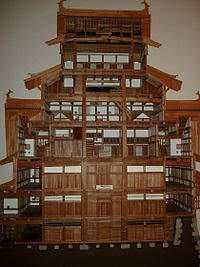- Nagare-zukuri
-
 Ujigami Shrine in Uji, Kyoto Prefecture
Ujigami Shrine in Uji, Kyoto Prefecture
The nagare-zukuri (流造 flowing style) or nagare hafu-zukuri (流破風造 flowing gabled style) is a traditional Shinto shrine architectural style characterized by a very asymmetrical gabled roof (kirizuma-yane (切妻屋根)) projecting outwards on one of the non-gabled sides, above the main entrance, to form a portico (see photo).[1] This is the feature which gives it its name. It is the most common style among shrines all over the country. The fact that the building has its main entrance on the side which runs parallel to the roof's ridge (non gabled-side) makes it belong to the so-called hirairi or hirairi-zukuri (平入・平入造) style.
Contents
Design
Sometimes its basic layout, consisting of an elevated core (母屋 moya) partially surrounded by a veranda called hisashi (all under the same roof), is modified by the addition of a room in front of the entrance.[1] A nagare-zukuri honden (sactuary) varies in roof ridge length from 1 to 11 ken,[2] but is never 6 or 8 ken.[3] The most common sizes are 1 and 3 ken. The oldest shrine in Japan, Uji's Ujigami Shrine, has a honden of this type. Its external dimensions are 5x3 ken, but internally it is composed of three sanctuaries (内殿 naiden) measuring 1 ken each.[3]
Variation
Ryōnagare-zukuri
Ryōnagare-zukuri (両流造 double flow style) is an evolution of the nagare-zukuri in which the roof flows down to form a portico on both non-gabled sides.[1] Examples are the honden at Itsukushima Shrine and that at Matsuo Taisha in Kyoto.
Kasuga-zukuri and nagare-zukuri
While superficially completely different, the nagare-zukuri style actually shares an ancestry with the second most popular style in Japan, the kasuga-zukuri.[4]
The two for example share pillars set over a double-cross-shaped foundation and a roof which extends over the main entrance, covering a veranda. (The Kasuga-zukuri is the only tsumairi style to possess this last feature.) The foundation's configuration is typical not of permanent, but of temporary shrines, built to be periodically moved. This shows that, for example, both the nagare-zukuri Kamo Shrine and Kasuga Taisha used to be dedicated to a mountain cult, and that they had to be moved to follow the movements of the kami.[4]
The styles also share a veranda in front of the main entrance, which makes it likely they both evolved from a simple gabled roof.
Notes
- ^ a b c History and Typology of Shrine Architecture, Encyclopedia of Shinto accessed on November 2009
- ^ The ken is the distance between one supporting pillar and another, a quantity which can vary from shrine to shrine and even within the same building.
- ^ a b JAANUS, Nagare-zukuri, accessed on December 1, 2009
- ^ a b Fujita Masaya, Koga Shūsaku, ed (April 10, 1990) (in Japanese). Nihon Kenchiku-shi (September 30, 2008 ed.). Shōwa-dō. ISBN 4-8122-9805-9.
Elements of Japanese architecture Styles Buddhist · Buke · Daibutsuyō · Gassho · Giyōfū · Hachiman · Hirairi · Hiyoshi (also called Hie) · Irimoya · Ishi-no-ma · Kasuga · Kibitsu · Nagare · Ōbaku Zen · Setchūyō · Shinden · Shinmei · Shinto · Shoin · Sukiya · Sumiyoshi · Taisha · Wayō · ZenshūyōA model of Himeji Castle
Building types Roof styles Structural Burdock piling · Chigi · Disordered piling · Engawa · Fusuma · Hisashi · Irimoya-zukuri · Irori · Jinmaku · Katōmado · Katsuogi · Kuruwa · Mokoshi · Moya · Nakazonae · Namako wall · Nightingale floor · Onigawara · Ranma · Shōji (see also washi) · Sōrin · Tamagaki · Tatami · Tokonoma · Tokyō · Tsumairi · ShibiGates and approaches Rooms Furnishings Outdoor objects Measurements Groups See also Shinto shrine Shinto architecture Buildings - chōzuya or temizuya
- haiden
- heiden
- hokora
- honden / shinden / shōden
- kagura-den
- massha
- sessha
Architectonic elements Styles - hirairi-zukuri
- tsumairi-zukuri
- gongen-zukuri
- hachiman-zukuri
- hiyoshi-zukuri
- irimoya-zukuri
- ishi-no-ma-zukuri
- kasuga-zukuri
- kibitsu-zukuri
- misedana-zukuri
- nagare-zukuri
- ōtori-zukuri
- owari-zukuri
- ryōnagare-zukuri
- shinmei-zukuri
- sumiyoshi-zukuri
- taisha-zukuri
Others Implements Main kami Staff Head shrines1 - Fushimi Inari Taisha
- Usa Hachiman-gū
- Ise Grand Shrine
- Dazaifu Tenman-gū
- Munakata Taisha
- Suwa Taisha
- Hiyoshi Taisha
- Kumano Nachi Taisha
- Tsushima Shrine
- Yasaka Shrine
Miscellaneous 1 (in order of the size of the shrine network they head)
Categories:
Wikimedia Foundation. 2010.


